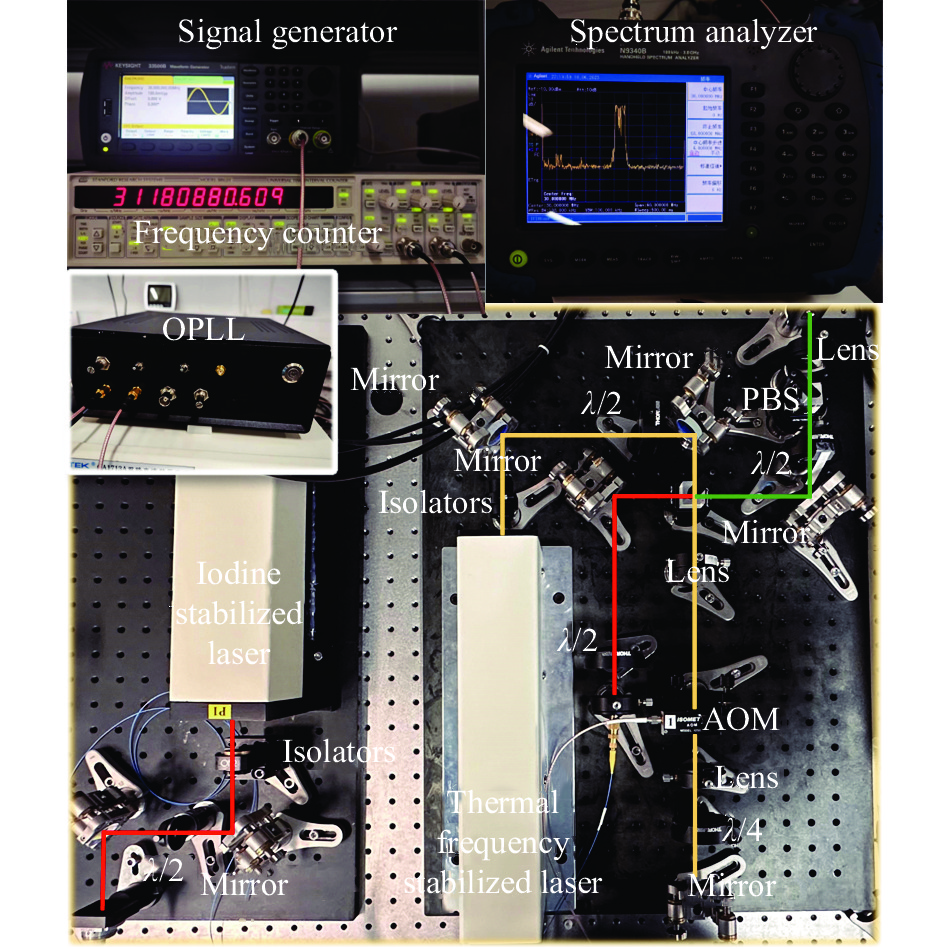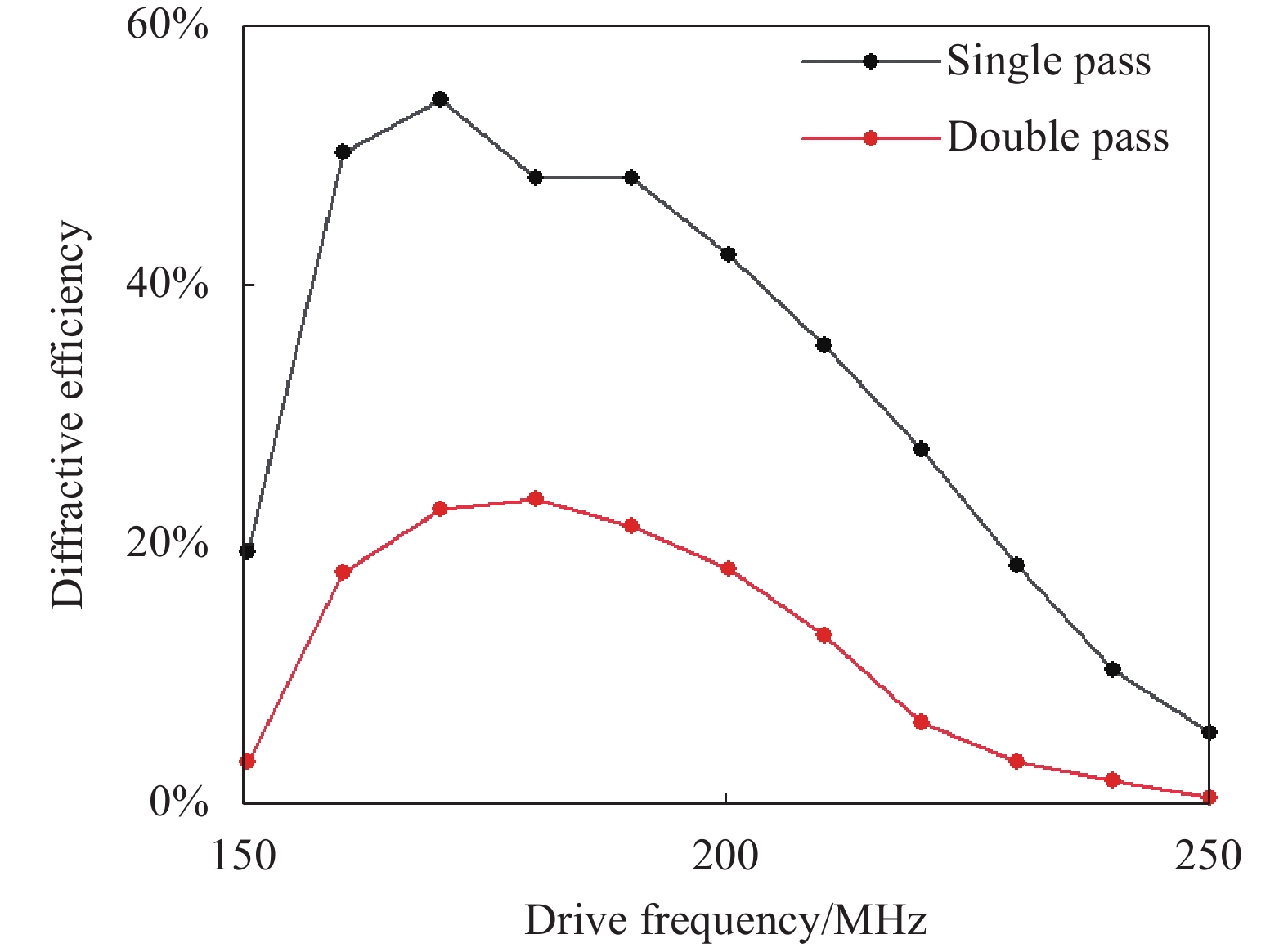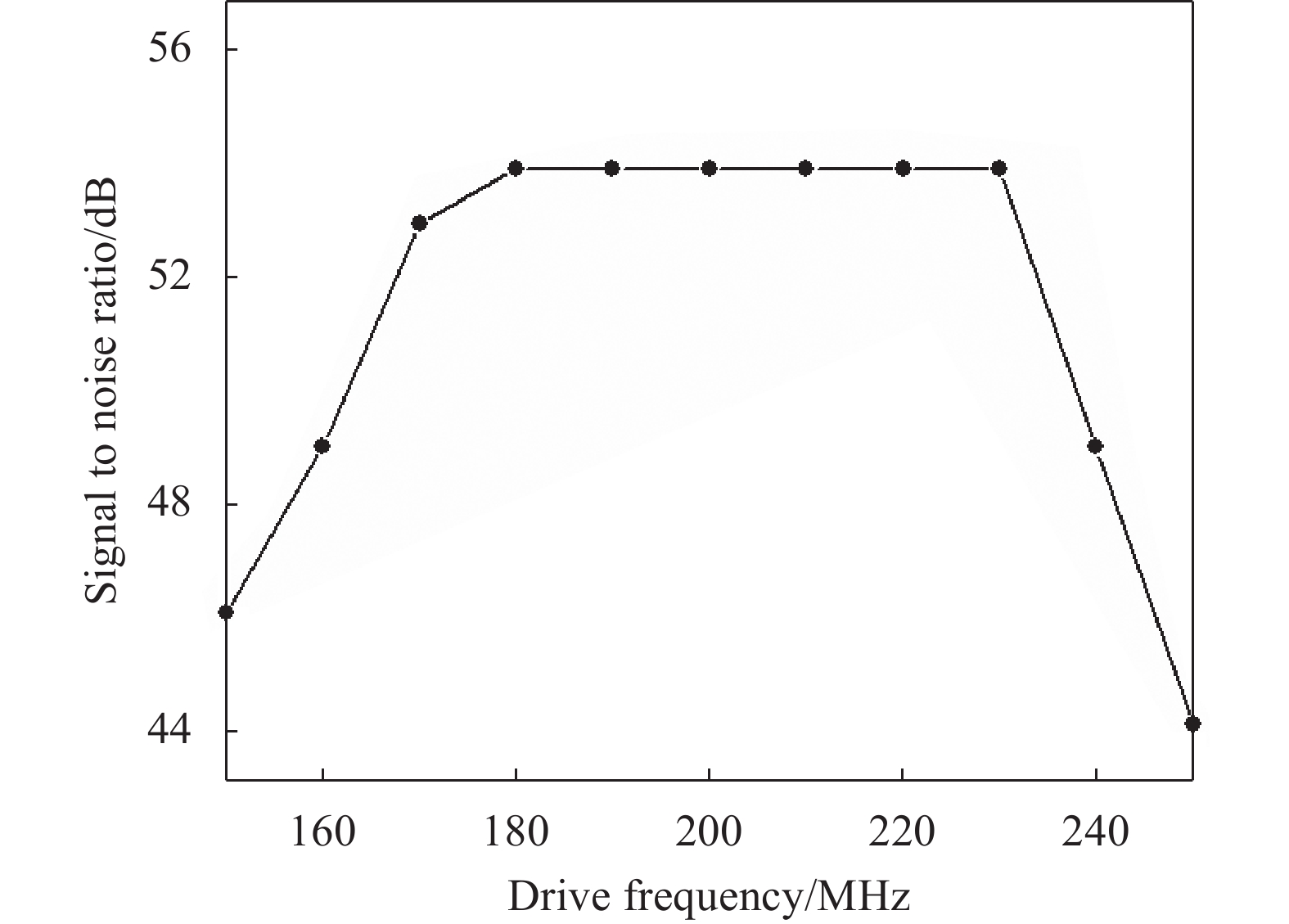-
近年来,航空航天和微电子产业迅速发展,使得对超精密测量领域的要求也越来越高。He-Ne激光器因具有高相干性[1]在机械与超精密测量领域被广泛应用[2]。激光干涉测量法因具有非接触、测量精度高、测量量程大和可多通道分光测量等优点,成为当前主流的高精度测量方法[3]。然而,激光干涉测量法对作为波长标尺的激光器提出了较高的要求,激光器必须利用适当稳频方法提高其输出光频率的稳定度、准确度后才能作为可靠的测量光源使用。
He-Ne激光器的稳频方法可分为被动稳频和主动稳频两种。被动稳频方法主要采取一些措施降低外界扰动造成的影响,例如利用热膨胀系数低的材料制作谐振腔的间隔器;或将热膨胀系数为负值的材料与热膨胀系数为正值的材料按一定长度配合,以使热膨胀互相抵消,实现稳频。主动稳频是一种闭环反馈控制调节的方法,相较于被动稳频,它可以达到更高的频率准确度和稳定度。主动稳频方法有兰姆凹陷稳频技术、塞曼效应激光稳频技术、双纵模热稳频技术、碘饱和吸收稳频技术等[4]。其中,双纵模热稳频He-Ne激光器具有高频率稳定性、良好的光束质量[5]和低成本的优点,适合作为激光干涉测量法的波长标尺激光器,但是传统的热稳频激光器频率稳定度和复现性较差,不能进一步满足高精度激光干涉测量法对激光器的频率稳定度和准确度的要求。
传统的双纵模热稳频激光器的相对频率变化量在$ {10}^{-8} $量级[5]。2018年,德国伊尔默瑙工业大学利用光学锁相环对He-Ne激光器进行偏频锁定,锁定后的拍频波动低于166 Hz[6]。2020年,哈尔滨工业大学利用声光调制器(Acousto-Optic Modulator, AOM)将连续激光器偏频锁定至光梳,拍频波动在±7 Hz以内[7]。2021年,中国计量科学研究院研制的利用光所锁相环反馈到可调谐外腔半导体激光器的电流调制端口进行偏频锁定,拍频波动在±0.3 Hz以内[8]。
文中报道了一种基于AOM和光学锁相环相结合的热稳频He-Ne激光偏频锁定系统。该系统结合了AOM的高频率响应特性和光学锁相环的高灵敏度特性,可以实现热稳频He-Ne激光器快速、准确的频率锁定。实验中,He-Ne激光器光束两次经过AOM移频后与参考光源碘稳频He-Ne激光器进行拍频,拍频信号通过光学锁相环对AOM进行负反馈控制,使得AOM通过频率补偿方式将激光频率偏频锁定至碘稳频激光器。系统锁定后3 h内,激光束和碘稳频激光的拍频频率波动小于0.2 Hz,标准差为0.04 Hz,闭环进入锁定状态所需时间小于10 ms。采用这种方式可实现对热稳频He-Ne激光器长时间、高稳定度的锁定。
-
基于AOM的光学锁相环偏频锁定系统同时具有AOM的高频率响应特性和光学锁相环的高灵敏度特性,能够快速对误差信号做出反应,实现快速、准确的相位锁定。
实验选用基于碘分子腔内饱和吸收稳频的高稳定He-Ne激光作为波长参考光源,用于偏频锁定热稳频全内腔He-Ne激光器。碘稳频He-Ne激光器频率稳定度高、复现性好,是国际主流的633 nm波长参考光源,以它作为频率标准,可以实现基于光学锁相环的高稳定度锁定。该激光器采用半内腔结构的腔内饱和吸收方式,利用碘分子反兰姆凹陷光谱实现激光频率的精准锁定,波长的相对标准不确定度达到E-12量级,频率稳定度达到1 E-11(1 s)[9],为热稳频He-Ne激光光学锁相环锁定提供了理想的参考频率。
热稳频He-Ne激光器的光学锁相环偏频锁定系统原理如图1所示。图1(a)为拍频信号模块,从激光器发出的光束首先通过半波片改变自身的偏振状态,使光束尽可能多的向后传递。之后光束通过偏振分光棱镜(PBS)被分为反射光和透射光,透射光经过凸透镜会聚入射到AOM中。当光束第一次经过AOM衍射后,使一级衍射光通过四分之一波片和反射镜,经反射镜反射后再次通过四分之一波片(此时光束两次经过四分之一波片,偏振方向旋转$ \pi /2 $),再经过凸透镜会聚入射到AOM中。此时两束光的偏振态互相垂直,无法产生拍频,因此需要再通过一个半波片改变合束光的偏振状态,再通过PBS产生拍频信号。图1(a)中模块产生的拍频信号通过功分器分为三路,一路传入频谱仪用于观察拍频信号,一路传入频率计数器用于计数,最后一路传入图1(c)中模块。图1(c)中模块首先将拍频信号和参考信号转换成方波,然后将两路方波信号输入到鉴频鉴相器得到误差信号,最后,PID控制电路将误差信号转换成控制信号,反馈输入到AOM进行偏频锁定。该系统依据AOM双次通过光路和光学锁相环原理设计,主要包括光源及拍频信号模块、光学锁相环电路模块和拍频监测模块三部分。搭建的光学锁相环系统实物如图2所示。
-
为了实现全内腔热稳频He-Ne激光器的频率调谐,实验选取AOM作为频率调谐和反馈单元。AOM由声光介质和压电换能器构成[10]。当驱动源的某种特定载波频率驱动换能器时,换能器能够产生同一频率的超声波并传入声光介质,在介质内形成折射率变化,光束通过介质时会发生相互作用而改变光的传播方向,即发生衍射。但是采用AOM的光路会存在一个问题:经过AOM移频后,衍射光的衍射角会随着入射光频率的改变而改变,导致系统的光路失去唯一性,无法产生稳定的拍频信号。
为了解决AOM的衍射角依赖问题,文中采用双次通过光路[11−14]来防止激光束方向随着驱动频率的改变而发生变化:当激光束入射到AOM中,AOM使激光束发生衍射,其一阶衍射光以一个小角度出射,并且产生移频,角度可以作为AOM的输入功率和驱动频率的函数。为了避免光束路径对$ \theta $的依赖,在AOM后方放置一个凸透镜,AOM到凸透镜的距离等于透镜的焦距,这样保证了AOM的所有出射光经过透镜后以平行光出射。在透镜的后方有一面反射镜,所有的出射光经过反射镜后会原路返回,再次进入AOM。为了防止零级光也经过反射镜后再次进入拍频光路,需要在反射镜的前面用光阑将零级光挡住,只允许一阶衍射光被反射镜反射并再次通过AOM返回,以确保即使角度发生了变化,返回光束的一阶衍射光与入射光束相比不会改变其光束路径(见图3)。基于双次通过光路搭建的系统有效避免了光束路径对$ \theta $的依赖,克服了因为$ \theta $角度变化而导致的拍频信号无法重合的问题。
AOM的驱动频率和输入电压的关系如图4所示,可以看出,在调制频率为150~250 MHz的区间内与驱动控制电压呈线性关系。因为文中采用Double-pass的光路设计,所以热稳频激光器经过AOM以后的频率为:
式中:${f、f}_{{a}}$分别为经过AOM移频前后激光器频率;${f}_{{\rm{AOM}}}$为AOM的驱动频率。因此,该系统的可调谐频率范围为$ 2{\Delta f}_{\mathrm{A}\mathrm{O}\mathrm{M}} $,约为200 MHz。
-
光学锁相环[15−19]主要由参考激光器、待锁定激光器、光电接收器、鉴频鉴相器、环路滤波器以及PI控制电路组成,其与传统的锁相环工作原理相类似。光电接收器先将接收到的光信号转换为电信号;鉴频鉴相器探测出拍频信号与参考信号相位之差,并输出与之对应的误差信号;环路滤波器根据环路的需求对这一误差信号进行滤波、去噪;经过滤波得到的误差信号最后经过PI控制电路处理,产生一个控制信号,控制信号反馈输出到待锁定激光器上,对激光器的频率进行控制,从而实现闭环控制。
光学锁相环的环路模型如图5所示,这是一个相位负反馈的误差控制系统,图中,${U}_{{\rm{d}}}\mathrm{sin}\left[\cdot\right]$为鉴频鉴相器的传递函数,$ F\left(p\right) $为环路滤波器的传递函数,${K}_{{\rm{p}}}+{K}_{{\rm{i}}}{\int }_{0}^{t}\left[\cdot\right]{\mathrm{d}}\tau$为PI控制器的传递函数,其中${K}_{{\rm{p}}}$和${K}_{{\rm{i}}}$分别为比例系数和积分系数,$ {{K}_{0}}/{p} $为待锁定激光器的传递函数。待锁定激光器和参考激光器的拍频信号与参考频率信号进行比较,得到误差信号$ {\theta }_{\mathrm{e}}\left(t\right) $,由误差信号产生误差电压$ {u}_{\mathrm{d}}\left(t\right) $,误差电压经过环路滤波器和PI控制电路得到控制电压$ {u}_{\mathrm{c}}\left(t\right) $,控制电压加到待锁定激光器上使拍频信号向参考信号产生频率偏移。一旦达到两者频率相等时,在特定条件下,控制环路就能稳定工作,实现相位锁定。
-
实验中,碘稳频He-Ne激光器作为该系统的主激光器,热稳频He-Ne激光器和AOM共同作为从激光器。热稳频He-Ne激光器发出的激光束首先通过AOM进行第一次移频,经过反射镜反射后,再次通过AOM进行二次移频,经过二次移频后的光路路径不再依赖于出射角$ \theta $,即当AOM的驱动频率发生改变时,拍频光路依然能够保持不变,产生稳定的拍频信号。在通过AOM移频激光束的过程中,由于AOM的特性,入射光经过AOM会变成零级衍射光和一级衍射光,为了防止零级衍射光对实验系统产生影响,需要加入光阑隔离零级衍射光。
在确保两束零级光被光阑遮挡后,通过偏振分光棱镜使碘稳频He-Ne激光器的激光束与二次移频后的热稳频He-Ne激光器的激光束进行拍频,产生的拍频信号由光电探测器接收并转换成电信号,然后通过功分器分为三路,其中两路分别连接到频谱仪和频率计数器上,对拍频信号进行监视和计数,剩下的一路则进入锁相环系统进行闭环控制。
在构建拍频光路时,AOM的位置选择至关重要。实验中要求AOM的衍射效率尽可能高,以达到增强拍频信噪比的目的。双通道光路虽然克服了光路对$ \theta $角的依赖,但是同时两次经过AOM也会大幅度降低激光的功率。为了保证拍频信号的信噪比达到锁相环的要求,对AOM的安装位置进行了仔细优化,使其衍射效率最大。衍射效率和驱动电压的关系如图6所示。光电接收器接受到的拍频信号的信噪比与AOM驱动电压的关系如图7所示。图中数据表明,该系统中的双通道光路满足实验要求,在0~9 V区间内能够产生大于40 dB的高信噪比拍频信号,系统的可调谐波长范围为300~480 MHz。
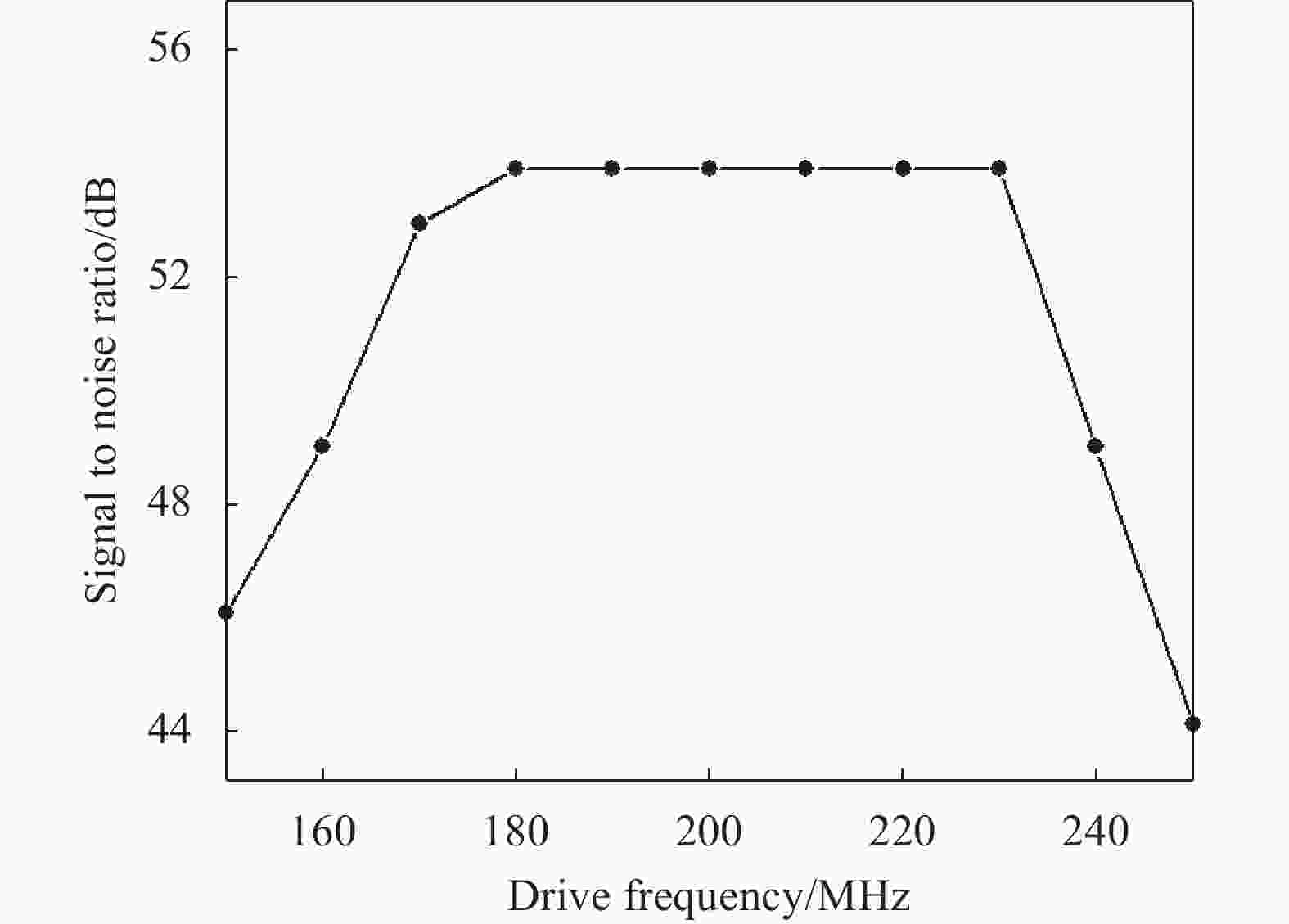
Figure 7. The relationship between signal to noise ratio of beat frequency signal and driving voltage
由图5可知,锁相环的系统增益函数由鉴频鉴相器、环路滤波器、PI控制电路和激光器自身的传递函数决定。由于鉴相器、环路滤波器和激光器自身的传递函数在系统设计时就已经确定,通过改变系统中PI控制电路的参数来改变系统的增益函数。PI控制电路的积分常数与系统闭环锁定后拍频信号的标准差的关系如图8所示。可以看出,当积分常数${K}_{{\rm{i}}}$在$ {1\times 10}^{6} $附近时,系统锁定后的标准差最小,低于0.05;当积分常数小于$ 1\times {10}^{4} $时,锁相环系统将无法实现环路锁定。
-
实验中采用基于腔内饱和吸收稳频的高稳定He-Ne激光器作为热稳频激光器锁定的波长参考源。通过与碘稳频激光波长基准的拍频测量,结果显示该碘稳频激光的1 s波长稳定度为$ 1.3\times {10}^{-11} $,1000 s达到$ 4.1\times {10}^{-13} $,复现性优于$ 1.0\times {10}^{-11} $。
实验中使用的信号发生器、频率计数器、偏频锁定的射频频率以及频谱仪等均采用高稳定外部频率参考源进行外促发同步。高稳定外部频率参考源可通过GPS、北斗以及光纤传输的方式溯源至时间频率基准,保证了其量值的准确性。
开环状态下的拍频信号如图9(a)所示,此时碘稳频激光器和热稳频激光器的输出功率分别为200 μW和700 μW,信号发生器输入的偏频频率为30 MHz。拍频信号的功率约为70 μW,信噪比为56 dB,线宽约为6 MHz,该线宽是碘稳频激光器频率调制产生的边带效应所导致。图9(a)中,在50 MHz处的信号是拍频的二次谐波信号,由于高次谐波的信噪比低于40 dB,故不会对系统的锁定产生影响。在AOM的可调谐波长范围内,通过调节AOM的驱动电压来获得信噪比大于40 dB的拍频信号,以满足光学锁相环系统正常工作对信号信噪比的要求。

Figure 9. (a) Beat frequency spectrum before loop locking; (b) Beat frequency spectrum after loop locking; (c) Beat frequency signal expansion diagram; (d) AOM drive frequency map when the loop is not locked; (e) AOM drive frequency map during loop locking; (f) AOM drive frequency expansion diagram when the loop is not locked
当锁相环闭环锁定时,拍频信号将被闭环锁定至信号发生器产生的射频频率上。环路锁定后的拍频信号频谱如图9(b)、(c)所示,其中,图9(b)为扫宽为60 MHz时环路锁定状态下的拍频信号图9(c)为扫宽为2 MHz时环路锁定状态下的拍频信号展开图。可以看出,环路锁定后的拍频线宽小于2 kHz。图9(c)中,在30 MHz附近有许多尖峰,这些尖峰是由AOM产生的。
图9(d)、(f)为环路未锁定状态下的AOM驱动频率图。图9(f)为环路锁定状态下的驱动频率图,可以看出,在驱动频率附近有许多高次谐波,这也是图9(c)中尖峰的来源。图9(e)为系统锁定后AOM的驱动频率图,当环路锁定后,AOM的驱动频率由图9(d)变为图9(e),对比两图可以发现,AOM的频率线宽明显加宽,这是因为环路锁定状态下,AOM需要产生和碘稳频激光器相反的抖动来保证偏频锁定的稳定。
系统锁定后激光拍频的频率抖动如图10 所示,作为对比,图中给出了自由运转下拍频频率的漂移情况。实验中利用频率计数器在光学锁相环开环状态下对拍频信号进行30 min计数,然后将参考频率设置为30 MHz,使热稳频激光器锁定至碘稳频激光器,并继续对环路锁定以后的拍频频率进行180 min计数,拍频频率被锁定在30 MHz偏置频率上,波动范围在±0.2 Hz以下,实现了热稳频激光器相对于碘稳频激光器的高稳定度偏频锁定。
光学锁相环偏频频率的相对阿伦方差[20]和参考频率的相对阿伦方差如图11所示。其中,锁相环系统的1 s和1000 s积分时间的相对阿伦方差分为别$ 3.3\times {10}^{-9} $和$ 1.4\times {10}^{-12} $,参考频率的1 s和1000 s积分时间的相对阿伦方差分别为$ 1.8\times {10}^{-10}\mathrm{和}3.9\times {10}^{-13} $,满足$ 1/\tau $下降规律。该结果表明,经过长时间的锁定后,光学锁相环系统的阿伦方差和参考信号的阿伦方差已经十分接近,达到了理想的锁定效果。
-
文中介绍了一种基于AOM与光学锁相环相结合的高稳定度激光稳频方法。利用自主研制的光学锁相环系统进行了热稳频全内腔He-Ne激光器偏频锁定至碘稳频激光器的实验,通过基于AOM的拍频信号检测单元将拍频信号的信噪比提升至40 dB以上,采用数字鉴频鉴相器和PI控制电路对AOM进行反馈控制,实现光学锁相环的闭环控制。偏频频率为30 MHz时,系统锁定后3 h内的拍频频率抖动均在$ \pm 0.2 $ Hz以内。光学锁相环系统在1 s和1000 s积分时间的相对阿伦方差分别为$ 3.3\times {10}^{-9} $和$ 1.4\times {10}^{-12} $。
综上所述,基于AOM和光学锁相环的高稳定度激光稳频方法相较于传统的热稳频激光器,利用光学锁相环对AOM进行反馈控制,弥补了传统热稳频激光器频率响应低的缺点,实现了亚赫兹级的偏频锁定,显著提高了热稳频He-Ne激光器的频率稳定度,使其能够满足超精密干涉测量和超灵敏光谱探测等领域对激光频率稳定度和准确度的要求。
Frequency stabilization method of optical phase-locked loop He-Ne laser based on acousto-optic modulator
doi: 10.3788/IRLA20240003
- Received Date: 2024-01-04
- Rev Recd Date: 2024-01-31
- Publish Date: 2024-03-21
-
Key words:
- laser frequency stabilization /
- audio-optic modulator /
- optical phase-locked loop /
- bias locking
Abstract:



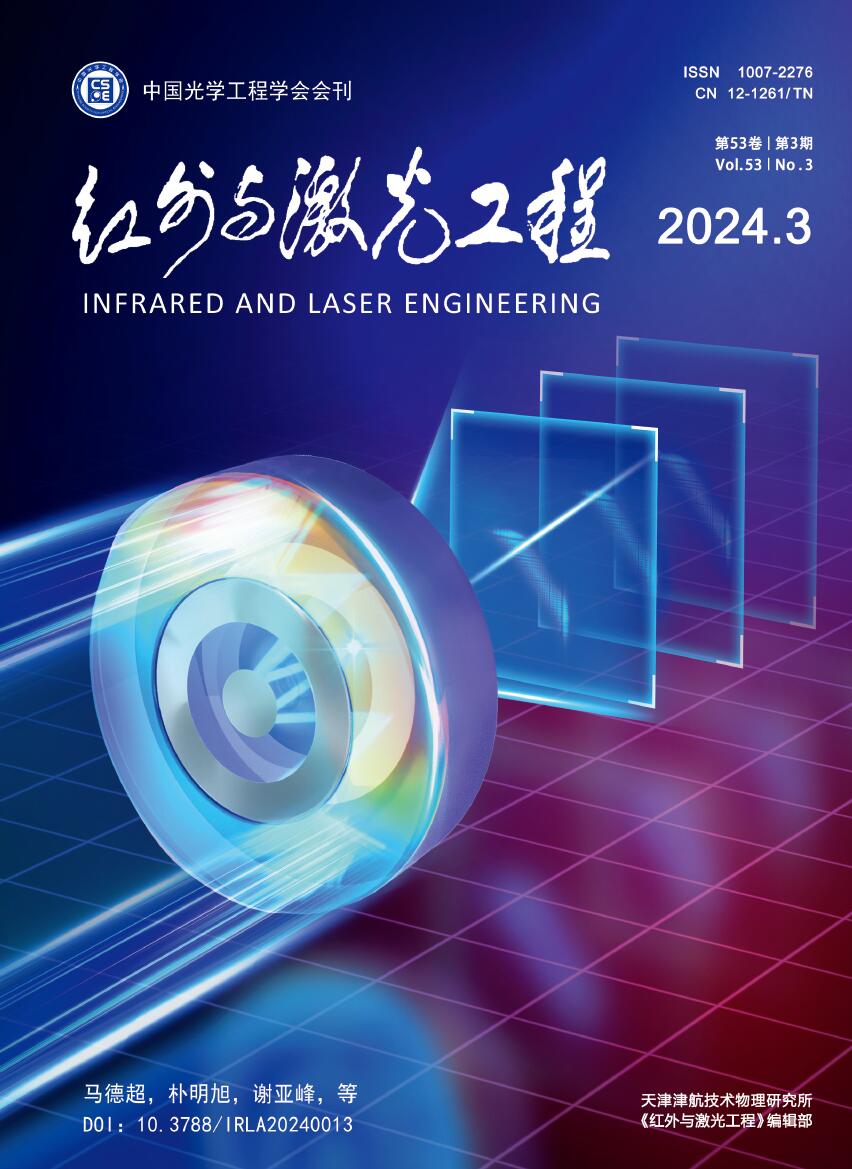






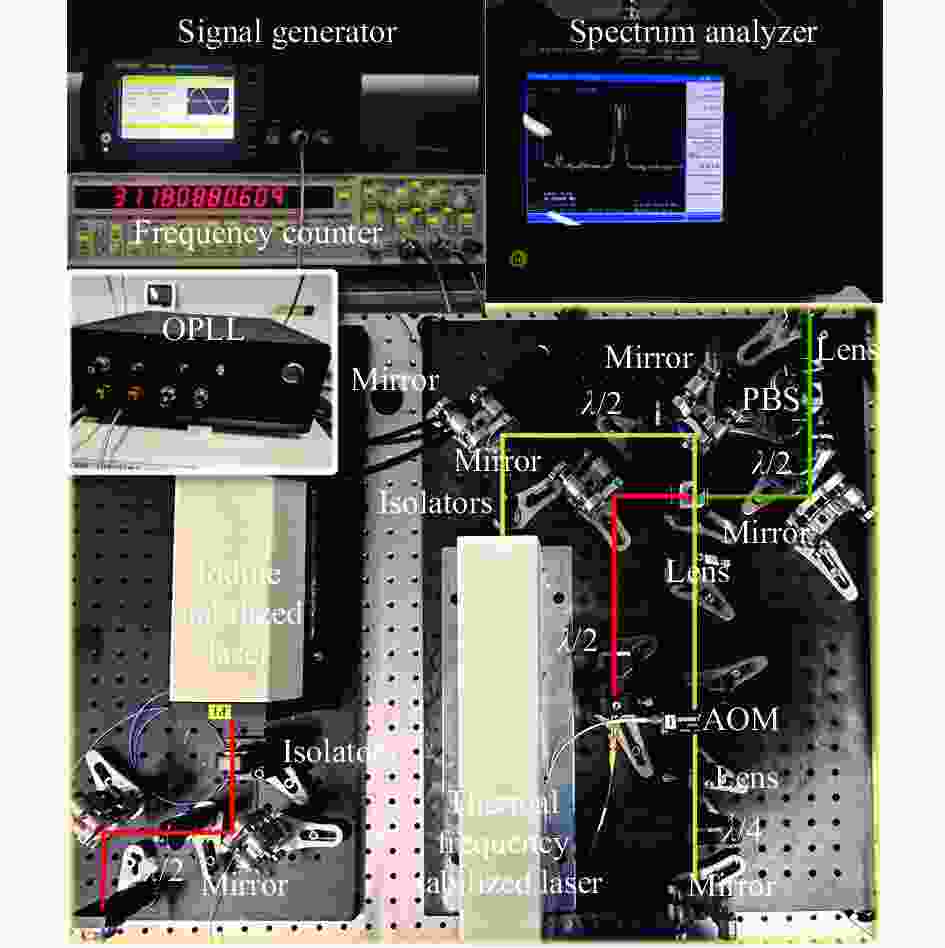


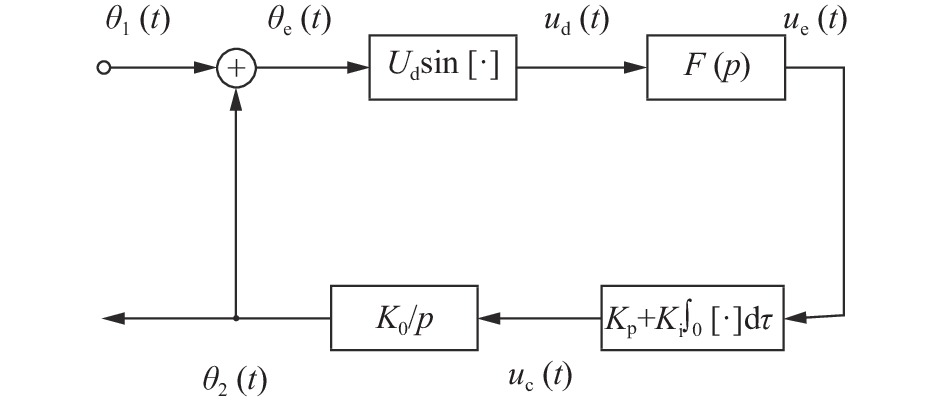

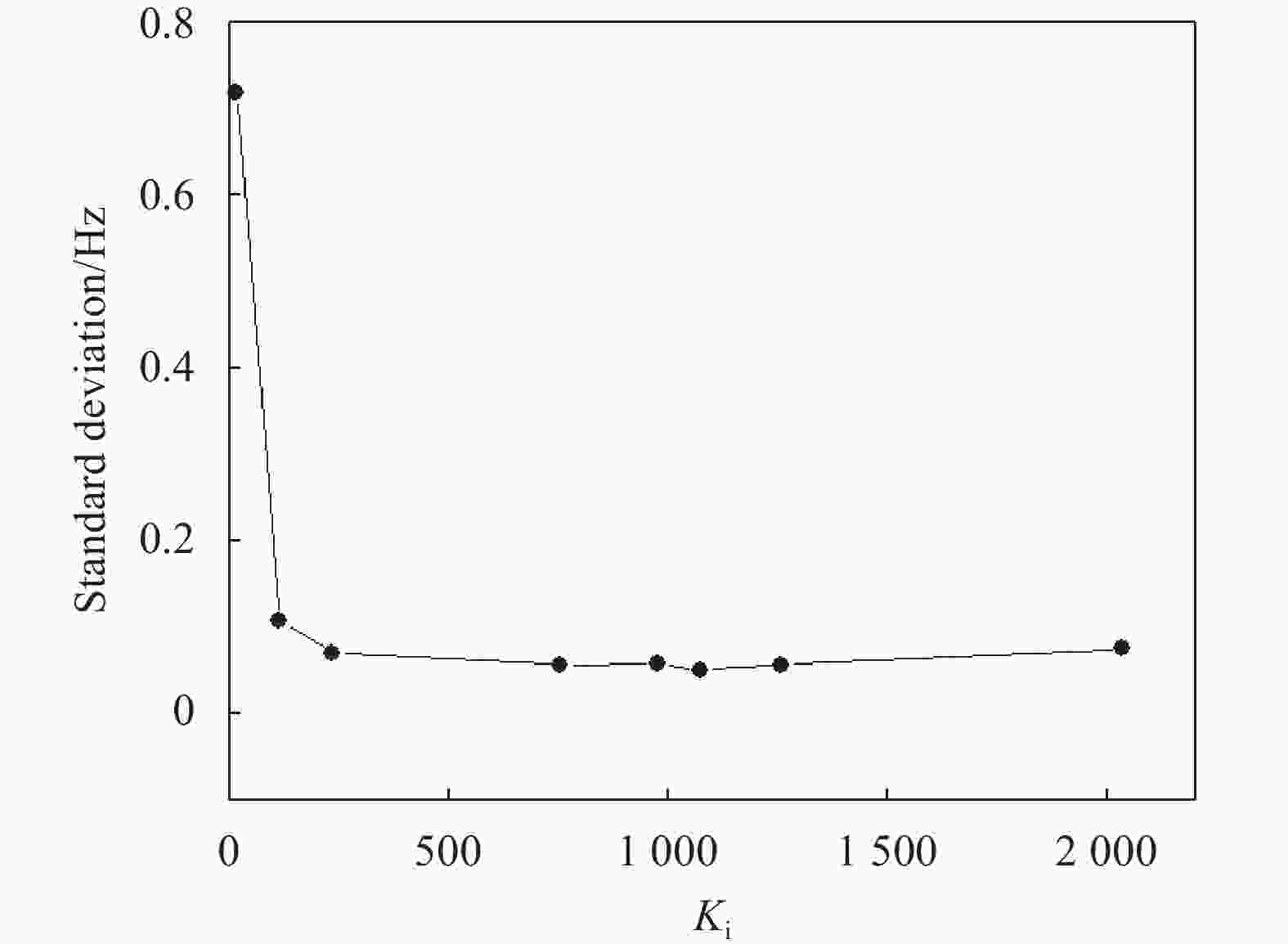
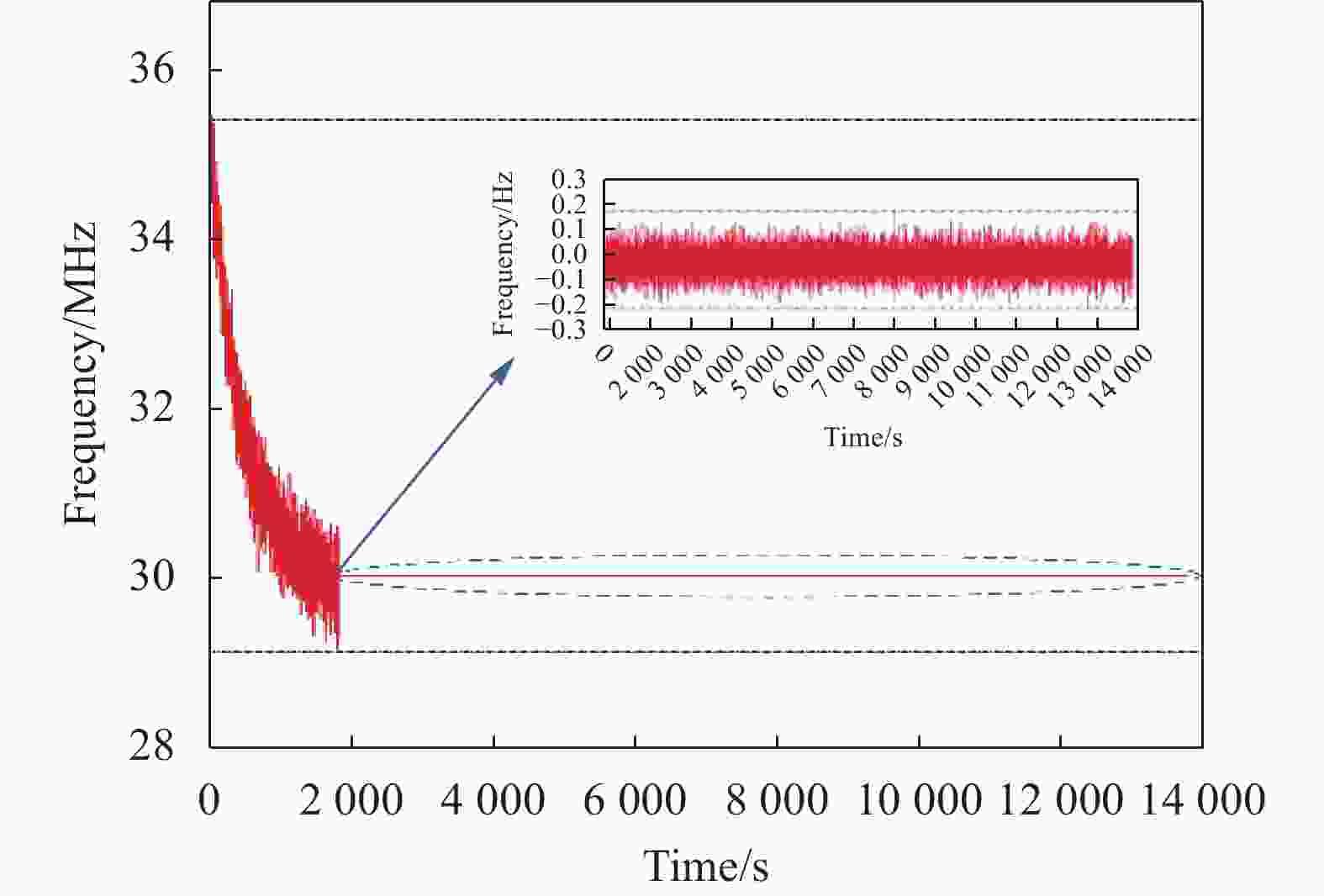


 DownLoad:
DownLoad:
